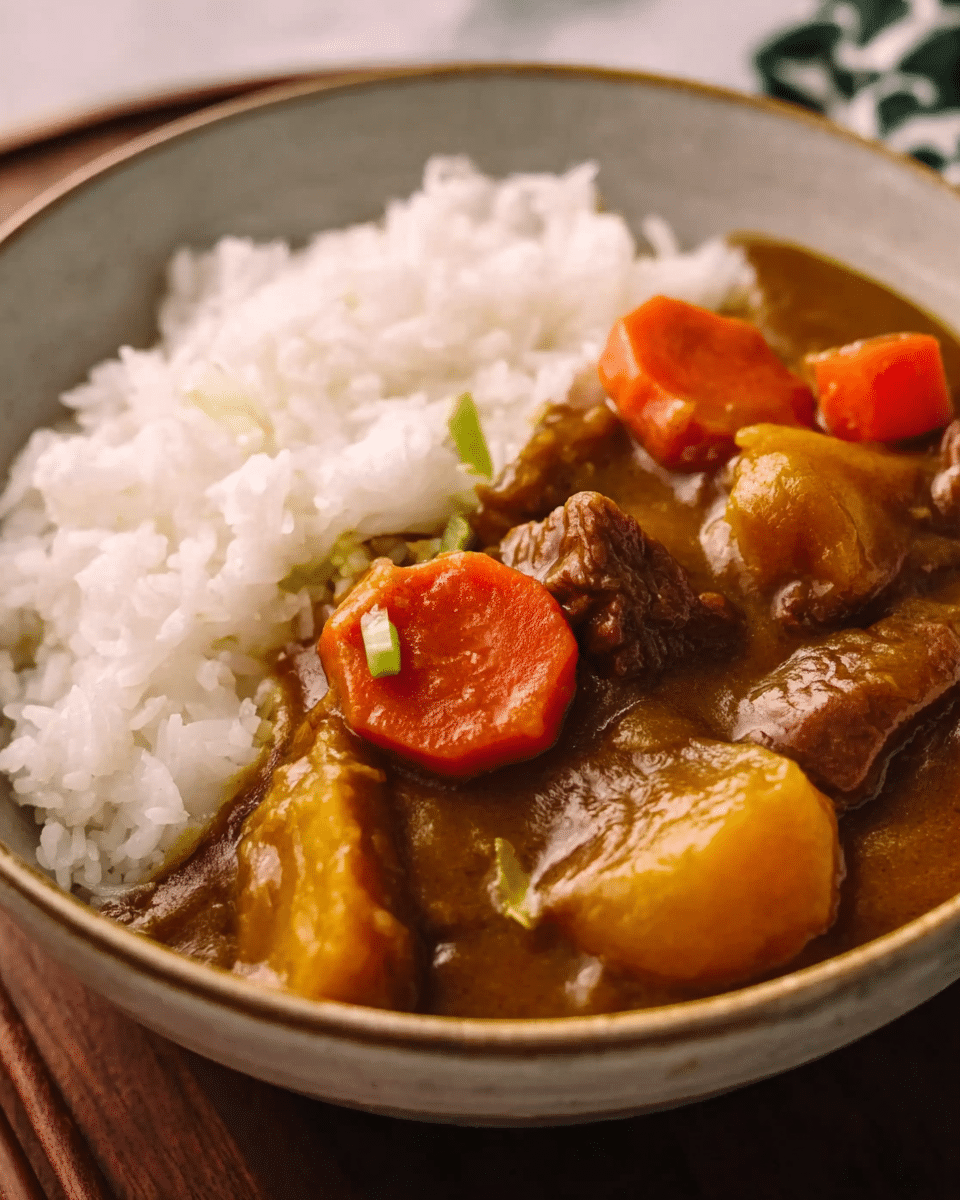Japanese Curry on Rice (Kare Raisu) is a beloved comfort food in Japan, perfect for those chilly fall or winter days. This rich, hearty dish features tender beef and vegetables in a flavorful, thick curry sauce, served over steaming rice. The combination of sweet, savory, and umami flavors makes it a crowd favorite, especially for meal prep or family dinners.
Full Recipe:
Ingredients
-
For the Curry
-
2 large onions
-
2 medium carrots
-
3 Yukon gold potatoes
-
2 cloves garlic
-
1 tbsp butter
-
5 cups water (or stock)
-
1 lb cubed beef (or other protein like chicken, tofu, or seafood)
-
8 oz Japanese curry roux (any brand you prefer)
-
-
Flavor Enhancers (optional)
-
1 tbsp Worcestershire sauce
-
1 tbsp ketchup
-
1 tbsp honey
-
1 red apple (Fuji or Honeycrisp works best)
-
-
For the Rice
-
8 cups medium-grain white rice (or any preferred type)
-
Directions
-
Prepare the Ingredients: Chop potatoes, carrots, and onions into large chunks (about 1-inch in size). Mince garlic and grate the apple.
-
Soak the Potatoes: Place potato chunks in a bowl of warm water for 15 minutes to remove excess starch.
-
Sear the Beef: Salt the beef cubes and let them sit for 10 minutes at room temperature. Heat 1 teaspoon of oil in a pot, sear the beef for 2-3 minutes until browned on all sides, then remove from the pot.
-
Cook the Vegetables: In the same pot, add butter and sauté the onions for about 8 minutes until caramelized. Add garlic, sauté for 30 seconds, then add potatoes and carrots. Stir for 1 minute. Return the beef to the pot.
-
Simmer the Curry: Pour in 5 cups of water. Add optional flavor enhancers like grated apple, honey, Worcestershire sauce, and ketchup. Stir well. Cover and simmer on medium-low heat for 15 minutes, stirring occasionally.
-
Check for Doneness: Pierce a potato with a wooden chopstick; it’s done when it slides through easily.
-
Add the Curry Roux: Slowly add curry roux cubes, one or two at a time, dissolving each in the liquid. Stir frequently and let the curry simmer uncovered for 15 minutes until thickened.
-
Serve: Remove from heat and serve the curry over a bowl of rice.
Nutrients
This dish serves 8 and provides approximately:
-
Calories: 427
-
Carbohydrates: 69g
-
Protein: 18g
-
Fat: 8g
-
Saturated Fat: 4g
-
-
Cholesterol: 45mg
-
Sodium: 116mg
-
Potassium: 722mg
-
Fiber: 4g
-
Sugar: 8g
-
Vitamin A: 2617 IU
-
Vitamin C: 20mg
-
Calcium: 60mg
-
Iron: 2mg
The Popularity of Kare Raisu in Japan
Kare Raisu is one of the most popular comfort foods in Japan. While curry itself originated from India, it was introduced to Japan by the British during the Meiji era in the 19th century. Over time, it evolved into the dish we know today: a thick, hearty, and slightly sweet curry sauce served over rice. Unlike Indian curries, which can be spicier and more complex, Japanese curry is known for its mild yet deeply savory flavor. The dish became a staple in Japanese homes and is commonly served in schools, restaurants, and family kitchens. It is often a go-to meal for busy families, as it is easy to prepare, filling, and suitable for meal prepping.
The simplicity of Kare Raisu, combined with the satisfying combination of tender meat, vegetables, and rice, makes it a comfort food that brings a sense of warmth and nostalgia. It’s no wonder that this dish is so loved by people of all ages, from children to adults.
The Key Ingredients in Japanese Curry
Japanese curry features a variety of ingredients that come together to create its signature flavor. The base of the dish is the curry roux, a blend of spices and flour that thickens the sauce and gives it its deep, rich consistency. The roux is typically sold in blocks, which makes it convenient to use and ensures consistency in flavor. The beef or protein of your choice is usually sautéed, providing a meaty and hearty element to the dish. Vegetables such as onions, carrots, and potatoes are essential for adding texture, sweetness, and earthiness.
One distinctive feature of Japanese curry is the balance of flavors. Unlike some curry variations that lean heavily on spice, Japanese curry is milder and includes sweetness from ingredients like apples, honey, and ketchup. The addition of Worcestershire sauce further deepens the flavor with a tangy, umami-rich note. The combination of these ingredients creates a curry that is not overly spicy but rich in complexity and depth.
The Role of Curry Roux in Japanese Curry
The curry roux is the heart of Japanese curry, responsible for its thick texture and rich flavor. It typically consists of a blend of spices such as turmeric, cumin, coriander, and garam masala, along with flour and fat to create a smooth, paste-like consistency. The roux is sold in cubes or blocks, making it easy to use and ensuring that the curry sauce reaches the right thickness and consistency. While some people choose to make their own roux from scratch, using pre-made curry roux simplifies the process and ensures a consistent flavor.
When preparing the curry, the roux is gradually added to the simmering vegetables and stock, allowing it to dissolve and thicken the sauce. The curry roux is what gives the dish its signature texture, turning the liquid into a rich, hearty sauce that perfectly coats the vegetables and meat.
The Sweetness and Depth of Flavor in the Curry Sauce
One of the key characteristics of Japanese curry is its combination of savory and sweet flavors. The addition of grated apple to the curry sauce is a hallmark of this dish, as it adds natural sweetness and a fruity undertone that balances the savory richness of the curry. Japanese apples, such as Fuji or Honeycrisp, are ideal for this dish due to their sweetness and crisp texture. When grated, the apple dissolves into the sauce, providing a subtle sweetness that complements the other ingredients.
In addition to apple, other flavor enhancers like honey, Worcestershire sauce, and ketchup further contribute to the sauce’s balance. The Worcestershire sauce introduces a savory umami element, while the ketchup adds a tangy, slightly sweet flavor. The honey enhances the overall sweetness of the curry, creating a complex and well-rounded taste profile. This balance of flavors is what sets Japanese curry apart from other curries and makes it such a comforting and satisfying dish.
The Importance of Rice in Kare Raisu
The rice served with Kare Raisu is just as important as the curry itself. Traditionally, medium-grain white rice is used, as its slightly sticky texture helps to soak up the rich curry sauce. Japanese rice is known for its sticky consistency, which makes it perfect for pairing with flavorful dishes like curry. The rice provides a neutral base that contrasts with the bold flavors of the curry, allowing the meat and vegetables to shine. The soft, pillowy rice also helps balance the richness of the sauce, making each bite a satisfying combination of textures.
While medium-grain rice is the classic choice for this dish, other types of rice, such as short-grain or even brown rice, can be used depending on personal preference. Regardless of the rice variety, the combination of tender curry and fluffy rice is what makes Kare Raisu a comforting and filling meal.
Meal Prep and Family Dinners: The Convenience of Kare Raisu
One of the main reasons Kare Raisu is such a popular choice for family dinners and meal prep is its convenience. This dish can be made in large batches, making it perfect for feeding a crowd or preparing meals in advance. The curry sauce can be stored in the refrigerator for up to several days and even improves in flavor as it sits. The rice can be made in a large pot or rice cooker, ensuring that everyone gets a hearty portion.
When making Kare Raisu for meal prep, it’s a good idea to store the curry and rice separately to maintain the texture of the rice. The curry sauce can be reheated on the stove or in the microwave, and the rice can be steamed or reheated in the microwave for a quick and easy meal. This makes Kare Raisu an excellent choice for busy individuals or families looking for a comforting and filling meal that can be enjoyed throughout the week.
The Health Benefits of Kare Raisu
While Kare Raisu is a comfort food, it also offers several health benefits. The dish is packed with vegetables like carrots and potatoes, which provide essential vitamins and minerals. Carrots are rich in beta-carotene, which is converted into vitamin A and supports eye health, while potatoes are a great source of potassium and fiber. The beef or protein of choice adds a good amount of protein, which is essential for muscle repair and growth.
If you’re looking to make a lighter or more plant-based version of this dish, you can substitute the beef for tofu, tempeh, or even legumes like lentils or chickpeas. These alternatives provide plant-based protein while still maintaining the hearty texture of the meat. Additionally, using vegetable stock instead of water can add more depth of flavor and increase the dish’s nutritional value.
Conclusion
In conclusion, Japanese Curry on Rice (Kare Raisu) is a comforting and flavorful dish that brings together tender beef, hearty vegetables, and a rich, savory curry sauce. Its combination of sweet, savory, and umami flavors makes it a favorite for family dinners, meal prepping, and enjoying during colder months. The curry roux, along with the sweetness of apples and the tang of Worcestershire sauce, creates a perfectly balanced sauce that pairs beautifully with the sticky rice. Whether you’re enjoying this dish as a weeknight meal or preparing it for a larger gathering, Kare Raisu is a satisfying and comforting choice that never goes out of style. Its versatility, flavor, and ease of preparation make it a timeless meal that continues to warm hearts and fill stomachs.






